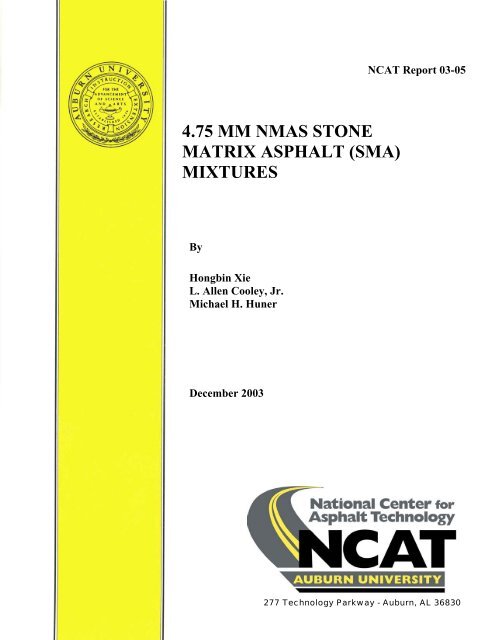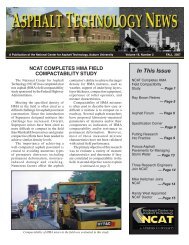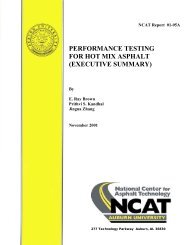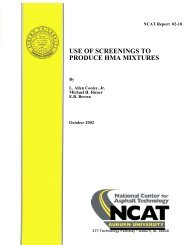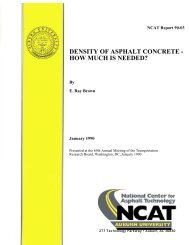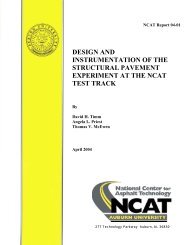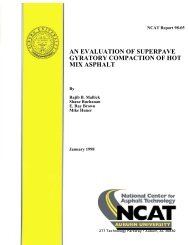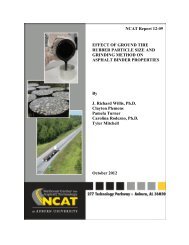4.75 mm nmas stone matrix asphalt (sma) mixtures - Auburn University
4.75 mm nmas stone matrix asphalt (sma) mixtures - Auburn University
4.75 mm nmas stone matrix asphalt (sma) mixtures - Auburn University
Create successful ePaper yourself
Turn your PDF publications into a flip-book with our unique Google optimized e-Paper software.
ABSTRACTThe use of <strong>4.75</strong> <strong>mm</strong> nominal maximum aggregate size (NMAS) hot mix <strong>asphalt</strong> hasrecently become a more attractive alternative to highway engineers because these mixeshave the potential to be used within a preventative maintenance program. The primaryreason for this attractiveness is that these mixes can be placed in thin lifts.Because of the recent research and experiences in developing <strong>4.75</strong> <strong>mm</strong> NMAS SMAmixes, a study was needed to further refine the design of <strong>4.75</strong> <strong>mm</strong> NMAS SMA mixes.Specifically, the fraction passing the 0.075 <strong>mm</strong> sieve and the currently specifieddraindown basket were evaluated.Based upon the test results and analyses, SMA mixes having a <strong>4.75</strong> <strong>mm</strong> NMAS cansometimes be successfully designed having gradations with aggregate fractions passingthe 0.075 <strong>mm</strong> sieve less than the currently specified 12 percent. Gradations withaggregate fractions passing the 0.075 <strong>mm</strong> sieve of 9 percent can be utilized as long as allother requirements are met.Draindown tests conducted using a wire mesh basket with 2.36 <strong>mm</strong> openings producedtest results with less draindown than tests conducted with a wire mesh basket having 6.3<strong>mm</strong> openings. It was concluded that the difference in draindown results between the twobasket types was related to the amount of mix that could fall through the different meshsize openings.KEY WORDS:Stone <strong>matrix</strong> <strong>asphalt</strong> (SMA), <strong>4.75</strong> <strong>mm</strong> NMAS, mix design, ruttingii
Xie, Cooley Jr., & HunerDraindown TestThe draindown test provides an evaluation of the draindown potential of an <strong>asphalt</strong> mixtureduring field production/transportation. The draindown test in this study was based on AASHTOT 305-97 using both the standard 6.3 <strong>mm</strong> wire cloth and the 2.36 <strong>mm</strong> wire cloth.A loose sample of <strong>asphalt</strong> mixture to be tested was placed in a wire basket which was positionedon a paper plate or other suitable container of known mass. The sample, basket, and plate orcontainer was then placed in a forced draft oven for one hour at a pre-selected temperature. Atthe end of one hour, the basket containing the sample was removed from the oven along with theplate or container and the mass of the plate or container determined. The difference in mass ofthe plate or container before and after the test was defined as the amount of draindown. Theacceptable amount of draindown measured for <strong>4.75</strong> SMA <strong>mixtures</strong> was set as 0.3% according toAASHTO MP8-01. The draindown test limit was set as 0.3% even though the 2.36 <strong>mm</strong> wirecloth was employed for the draindown test. Refinement of the specification limit for thisdraindown test by using the 2.36 <strong>mm</strong> sieve was not included in this study, further work will beneeded to determine the appropriate limit.TEST RESULTS AND ANALYSISMix DesignMix design results are su<strong>mm</strong>arized in Table 7 for the eight mix design combinations. Results areprovided for optimum binder content, VMA, VFA, VCA MIX and VCA DRC , % G <strong>mm</strong> @ N ini ,effective binder content, dust to effective binder ratio, and film thickness.Table 7. Mix Design ResultsAgg.TypeGRNLMSDustcontent,%VTMTotalAC,%VCA MIX , VCA DRC , VMA,% % %VFA,%% G <strong>mm</strong>@ N iniEff.AC,%Dust toEff. ACRatioFilmThickness, micron9 4 6.5 36.3 44.20 18.0 77.8 85.1 6.3 1.43 8.899 6 5.8 36.3 44.20 18.1 66.8 83.6 5.6 1.61 7.8412 4 6.0 35.4 44.20 16.8 76.2 85.7 5.8 2.07 7.1812 6 5.3 35.8 44.20 17.3 65.2 83.7 5.1 2.35 6.269 4 5.7 33.6 40.97 14.6 72.7 85.3 5.0 1.80 6.969 6 4.7 33.3 40.97 14.2 57.8 84.9 4.0 2.25 5.5112 4 5.4 33.3 40.97 14.0 71.5 85.0 4.7 2.55 5.7512 6 4.6 33.3 40.97 14.1 57.5 83.2 3.9 3.08 4.73Initial observation of Table 7 shows that all mixes met the criteria for <strong>stone</strong>-on-<strong>stone</strong> contact(VCA MIX less than VCA DRC ). None of the four lime<strong>stone</strong> mixes met the VMA requirements foran SMA (17 percent minimum).Optimum binder contents shown in Table 7 ranged from a low of 4.7 percent to a high of 6.5percent (Figure 5). On average the granite mixes had higher optimum binder content (average of5.9 percent) than the lime<strong>stone</strong> mixes (average of 5.1 percent).8
Xie, Cooley Jr., & HunerAs the percent passing the 0.075 <strong>mm</strong> sieve (P 0.075 ) increased, optimum <strong>asphalt</strong> content decreasedfor mixes using both aggregate types. For granite mixes, increasing the P 0.075 by 3 percent from 9to 12 percent generally reduced optimum <strong>asphalt</strong> content by 0.5 percent; however, for lime<strong>stone</strong>mixes, increasing the P 0.075 by 3 percent, from 9 to 12 percent, decreased optimum <strong>asphalt</strong>content by 0.2 percent.As expected, P 0.075 had the greatest effect on film thickness. The film thickness was calculatedbased on effective <strong>asphalt</strong> volume divided by aggregate surface area, and in this study mineralfiller was counted as aggregate to calculate surface area. The 9 and 12 percent P 0.075 mixes hadaverage film thickness of 7.30 and 5.98 microns, respectively. This data suggests that an increaseof 3 percent of P 0.075 resulted in an average decrease in film thickness of about 1.3 microns or 20percent.If the mineral filler is not counted as aggregate in calculating the surface area, the film thicknesswill significantly increase. The 9 and 12 percent P 0.075 mixes will have the same calculatedaggregate surface area, and have average film thickness of 12.18 and 11.32 microns,respectively. This data again suggests that an increase of mineral filler content resulted in lowerfilm thickness because of the decrease of the effective <strong>asphalt</strong> content.7.0Optimum Asphalt Contents, %6.56.05.55.04.54.04 6 4 6 4 6 4 69 12 9 12GraniteLime<strong>stone</strong>Figure 5. Range in Optimum Asphalt ContentsAlso as expected, the mixes designed at 4.0 percent air voids had higher average optimum<strong>asphalt</strong> contents (5.9 percent) than the mixes designed at 6.0 percent air voids (5.1 percent). The2.0 percent range in design air voids resulted in about 0.8 percent difference in optimum <strong>asphalt</strong>content.VMA values for the individual mixes ranged from a high of 18.1 percent to a low of 14.0 percent(Figure 6). As expected, VMA at optimum <strong>asphalt</strong> content was affected by the aggregate typeand P 0.075 . Design air voids did not appear to significantly affect the overall average VMA9
Xie, Cooley Jr., & Hunervalues. This is also as expected, since SMA has <strong>stone</strong> on <strong>stone</strong> contact, resulting in littledensification, the extra <strong>asphalt</strong> for 4 percent design air voids only serve to reduce the air voids.On average, the granite mixes had higher VMA (average 17.5 percent) than the lime<strong>stone</strong> mixes(average 14.3 percent). Also expected, when the P 0.075 increased, the average VMA of granitemixes decreased (from18.1 to 17.1 percent), the average VMA of lime<strong>stone</strong> slightly decreased(from 14.4 to 14.1 percent).Voids in Mineral Aggregate, %19.018.017.016.015.014.013.012.011.010.04 6 4 6 4 6 4 69 12 9 12GraniteLime<strong>stone</strong>Figure 6. Range in Voids in Mineral Aggregate ValuesVCA DRC values were 44.2 percent for the granite and 41.0 percent for the lime<strong>stone</strong> aggregates.VCA MIX values ranged from a low of 33.3 percent to a high of 36.3 percent (Figure 7). AllVCA MIX values were <strong>sma</strong>ller than the VCA DRC values, which indicates all mix designs hadcoarse aggregate on coarse aggregate contact. A sample picture of <strong>4.75</strong> <strong>mm</strong> SMA vertical crosssection is shown in Figure 8. The coarse aggregate on coarse aggregate structure can beobserved from Figure 8.10
Xie, Cooley Jr., & HunerVCA mixVCA drcVoids in Coarse Aggregate, %50.045.040.035.030.025.020.015.010.05.00.04 6 4 6 4 6 4 69 12 9 12GraniteLime<strong>stone</strong>Figure 7. Range in Voids in Coarse Aggregate ValuesFigure 8. Vertical Cross Section of <strong>4.75</strong> <strong>mm</strong> SMA (Lime<strong>stone</strong> @ 5.7% AC)Rut TestingTable 8 provides the Asphalt Pavement Analyzer (APA) rut depth data for the eight mixesevaluated in this study. Figure 9 illustrates all the rut data.11
Xie, Cooley Jr., & HunerTable 8. Results of Asphalt Pavement Analyzer TestingAgg. TypeGraniteLime<strong>stone</strong>Dust Air Voids,Content, % %912912Total BinderContent, %VMA, %VCA RatioAverage RutDepth, <strong>mm</strong>4 6.5 18.0 0.821 12.696 5.8 18.1 0.822 7.114 6.0 16.8 0.801 10.456 5.3 17.3 0.809 10.634 5.7 14.6 0.821 17.186 4.7 14.2 0.814 11.494 5.4 14.0 0.812 15.156 4.6 14.1 0.813 6.25All the rutting results shown in Table 8 and Figure 9 are relatively high compared to theconventional NMAS SMA (In Georgia DOT specification, the maximum APA rut depthreco<strong>mm</strong>ended for SMA is 5<strong>mm</strong> based on 100 psi hose pressure and 100 lb load). This may bemainly explained by the fact that non-modified <strong>asphalt</strong> was used in this study. Anotherpossibility for the high rut depth would be the <strong>sma</strong>ll NMAS in combination with 115<strong>mm</strong> sampleheight and the hose diameter within the APA testing. Since only thin layers will be expected tobe used with <strong>4.75</strong> <strong>mm</strong> SMA mixes, rutting would not be expected to be a major issue. Allrutting results are only used for relative comparisons and factor analysis.Initial analysis of this APA rut depth data was performed by conducting an analysis of variance(ANOVA) to evaluate the effect of the main factors (aggregate type, dust content, and design airvoids) and any interactions between the main factors on rut depths. Results of the ANOVA arepresented in Table 9.APA Rut Depths, <strong>mm</strong>20.0018.0016.0014.0012.0010.008.006.004.002.000.004 6 4 6 4 6 4 69 12 9 12GraniteLime<strong>stone</strong>Figure 9. Range in APA Rut Depth Values12
Xie, Cooley Jr., & Huner9% Dust 12% Dust16.0014.0012.00Rut Depth, <strong>mm</strong>10.008.006.004.002.000.00GraniteLime<strong>stone</strong>Figure 10. Interaction between Aggregate Type and Dust ContentRut Depth, <strong>mm</strong>4% VTM 6% VTM14.0012.0010.008.006.004.002.000.00GraniteLime<strong>stone</strong>Figure 11. Interaction between Aggregate Type and Design Air Voids ContentComparisons of Draindown BasketsDraindown tests were conducted using two baskets having different sieve cloth sizes: 6.3 <strong>mm</strong>and 2.36 <strong>mm</strong>. For both the granite and lime<strong>stone</strong> aggregates at 9 percent P 0.075 , draindown testswere conducted at the optimum binder content determined at 4 percent design air voids, testswere also conducted at the optimum plus up to 3 percent <strong>asphalt</strong> content to consider any fieldvariability. The goal of this testing was to determine whether the <strong>sma</strong>ller sized wire cloth wouldhelp prevent aggregate particles from falling through the basket. Results of this testing areshown in Table 10.14
Xie, Cooley Jr., & HunerTable 10. Results of Draindown TestingAggregateDustContent,%OptimumP b , %Percent Draindown, %Opt. P b , % Opt.+1% Opt.+2 Opt.+3%2.36 <strong>mm</strong> 1 6.3 <strong>mm</strong> 2.36 <strong>mm</strong> 6.3 <strong>mm</strong> 2.36 <strong>mm</strong> 6.3 <strong>mm</strong> 2.36 <strong>mm</strong> 6.3 <strong>mm</strong>Granite 9 6.5 0.00 0.07 0.02 0.31 NT 2 NT NT NTLime<strong>stone</strong> 9 5.7 0.00 0.00 NT NT 0.00 0.23 1.79 2.211. Mesh size of basket used in draindown test.2. NT – Not Tested.All of the draindown tests at optimum <strong>asphalt</strong> content showed essentially no draindown. Thissupports the idea presented previously that the surface area and relatively high dust contents willhelp prevent draindown for a <strong>4.75</strong> <strong>mm</strong> NMAS SMA mix. Based upon the mix design datapresented previously in Table 7, the granite mix had a higher optimum binder content (6.5percent) than the lime<strong>stone</strong> mix (5.7 percent). The granite mix was combined with <strong>asphalt</strong>binder at a binder content of optimum plus one percent and draindown tests conducted usingboth baskets. The results indicated that the test conducted with the 2.36 <strong>mm</strong> wire cloth provideda lower draindown result (0.02 percent) than the test conducted with the 6.3 <strong>mm</strong> wire cloth (0.31percent). The test conducted with the 6.3 <strong>mm</strong> wire cloth failed the requirement of 0.3 percentdraindown maximum.Because of the relatively low optimum binder content for the lime<strong>stone</strong> mix, it was prepared atoptimum plus 2 percent. Results of this testing indicated that neither test failed the requirementof maximum 0.3 percent draindown. However, again the results using the 2.36 <strong>mm</strong> wire clothwere lower in magnitude (0.00 percent compared to 0.23 percent draindown). Therefore, anadditional test was conducted at optimum binder content plus 3 percent. Both mixes failed themaximum requirement of 0.3 percent at this binder content. Once again, the results with the 2.36<strong>mm</strong> wire cloth basket were lower than for the standard basket (1.79 percent compared to 2.21percent draindown).Based upon the results of this draindown testing, it is obvious that the draindown using the 2.36<strong>mm</strong> wire cloth basket were lower than the results utilizing the 6.3 <strong>mm</strong> wire cloth basket. Thereare two possible explanations for this occurrence. First, because of the larger openings withinthe 6.3 <strong>mm</strong> wire cloth, aggregate particles were able to fall through the openings of the basketand were counted as draindown. The experiences of the authors have noted this to occur inprevious draindown tests using larger NMAS mixes. The second possibility has to do with theincreased surface area for the 2.36 <strong>mm</strong> wire cloth basket. Having a <strong>sma</strong>ller opening size, alongwith a basket of the same dimensions, indicates that there was more surface area covered by thewire mesh. Asphalt binder draining from the mix during the test may have stuck to the wiremesh and, therefore, not drained onto the container used under the basket. If a sufficient amountof binder stuck to the wire mesh, it would be anticipated that the test results with the 2.36 <strong>mm</strong>wire mesh basket would have produced lower draindown values.15
Xie, Cooley Jr., & HunerA sample picture of the draindown testing results comparing the two baskets with the twodifferent mesh sizes is shown in Figure 12. During testing of the different mixes, it was notedthat aggregate particles did indeed fall through the wire mesh onto the container when using thestandard mesh basket. From Figure 12, one can observe that the left plate (6.3 <strong>mm</strong> basket) hadmuch higher draindown amount than the right plate (2.36 <strong>mm</strong> basket). A significant part ofremains in the left plate were aggregate particles. Therefore, it was believed that aggregateparticles falling through the larger mesh accounted for the increase in draindown with the 6.3<strong>mm</strong> mesh, and was concluded to have predominantly caused the differences in draindown valuesbetween baskets having the two wire mesh sizes.Figure 12. Sample Draindown Test Results (Granite @ 7.5% AC)CONCLUSIONS AND RECOMMENDATIONSThe objective of this research study was to further refine the design of <strong>4.75</strong> <strong>mm</strong> NMAS SMA.Specifically, the fraction passing the 0.075 <strong>mm</strong> sieve and the draindown basket were evaluated.Based upon the test results and analyses from this limited study, the following are concluded:1. Based on the draindown test results, durability consideration, and relative comparisonof APA testing results, SMA mixes having a <strong>4.75</strong> <strong>mm</strong> NMAS can sometimes besuccessfully designed having gradations with aggregate fractions passing the 0.075<strong>mm</strong> sieve less than 12 percent. Gradations with aggregate fractions passing the 0.075<strong>mm</strong> sieve of 9 percent can be utilized as long as all other requirements are met.2. APA rutting results of <strong>4.75</strong> <strong>mm</strong> SMA in this study were relatively high for all the<strong>mixtures</strong> tested. This is mainly because the non-modified <strong>asphalt</strong> was used and highratio of sample height and NMAS was used for APA testing. Based on the APA testresults, <strong>4.75</strong> <strong>mm</strong> SMA with non-modified <strong>asphalt</strong> is not reco<strong>mm</strong>ended for highvolume traffic roads.16
Xie, Cooley Jr., & Huner3. Aggregate shape, angularity and texture played an important role in achieving therequired design volumetric criteria required for <strong>4.75</strong> <strong>mm</strong> NMAS SMA mixes. Withinthis study, the SMA mixes comprised of a granite aggregate passed all volumetriccriteria, while SMA mixes comprised of a lime<strong>stone</strong> aggregate failed VMA criteria.4. Draindown tests conducted using a wire mesh basket with 2.36 <strong>mm</strong> openingsproduced test results with less draindown than tests conducted with a wire meshbasket having 6.3 <strong>mm</strong> openings. It was concluded that the difference in draindownresults between the two basket types was related to the amount of aggregate thatcould fall through the different mesh size openings.Based upon the conclusions of this study, it is reco<strong>mm</strong>ended to change the gradation criteria onthe 0.075 <strong>mm</strong> sieve to between 9 and 15 percent from 12 to 15 percent. It is also reco<strong>mm</strong>endedto utilize a draindown basket having a 2.36 <strong>mm</strong> wire mesh size for <strong>4.75</strong> <strong>mm</strong> NMAS SMAinstead of the currently standard basket size of 6.3 <strong>mm</strong>. The specification limit of 0.3 percent fordraindown test when using 2.36 <strong>mm</strong> basket appears reasonable but needs further refinements.ACKNOWLEDGEMENTSThe authors thank the National Asphalt Pavement Association for their support in sponsoringthis study.REFERENCES1. Brown, E.R., R.B. Mallick, J.E. Haddock, and J. Bukowski. Performance of Stone MatrixAsphalt (SMA) Mixtures in the United States. In Journal of the Association of AsphaltPaving Technologists, Volume 66, 1997.2. Brown, E.R. and L.A. Cooley, Jr. “Designing Stone Matrix Asphalt Mixtures for Rut-Resistant Pavements.” National Cooperative Highway Research Program Report 425.Transportation Research Board, National Research Council. Washington, D.C. 1999.3. Cooley, L.A., Jr., E.R. Brown. Potential of Using Stone Matrix Asphalt (SMA) for ThinOverlays. NCAT Report 03-01. National Center for Asphalt Technology. <strong>Auburn</strong><strong>University</strong>. <strong>Auburn</strong>, Alabama. April 2003.4. Cooley, L.A., Jr., R.S. James, M.S. Buchanan. Development of Mix Design Criteria for<strong>4.75</strong> <strong>mm</strong> Superpave Mixes. Final NCAT Report. National Center for AsphaltTechnology. <strong>Auburn</strong> <strong>University</strong>. <strong>Auburn</strong>, Alabama. February 2002.5. Cooley, L.A., Jr., M.H. Huner, J. Zhang and E.R. Brown. Use of Screenings to ProduceHMA Mixtures. Presented at 82nd Annual Meeting of the Transportation ResearchBoard, Washington, D.C., January 2003.6. Vavrik, W.R, G. Huber, W.J. Pine, S.H. Carpenter, and R. Bailey. The Bailey Method ofGradation Evaluation: The Influence of Aggregate Gradation and Packing Characteristicson Voids in Mineral Aggregate. Presented at the Annual Meeting of the Association ofAsphalt Paving Technologists. Clearwater Beach, Florida, March 2001.17


